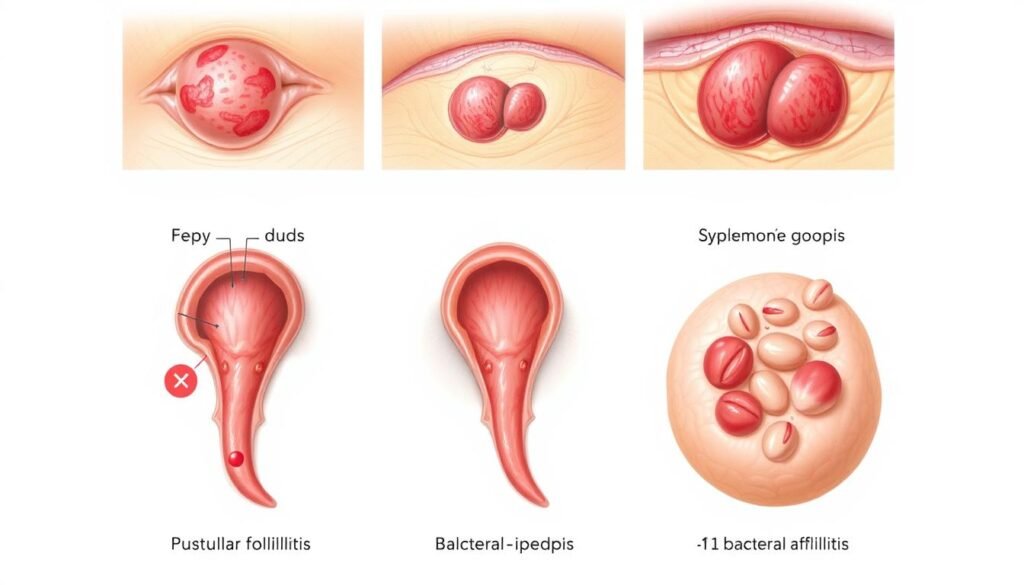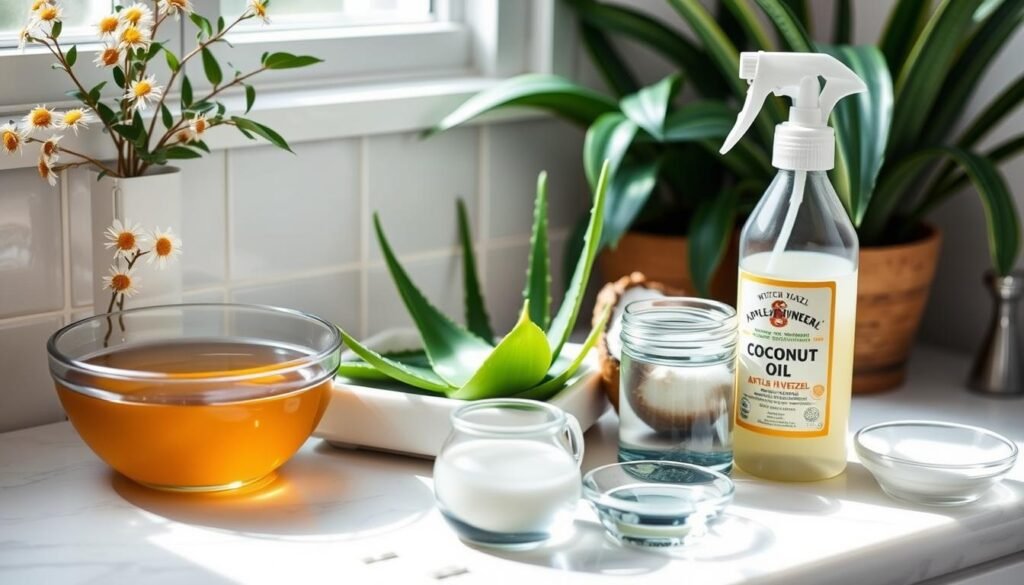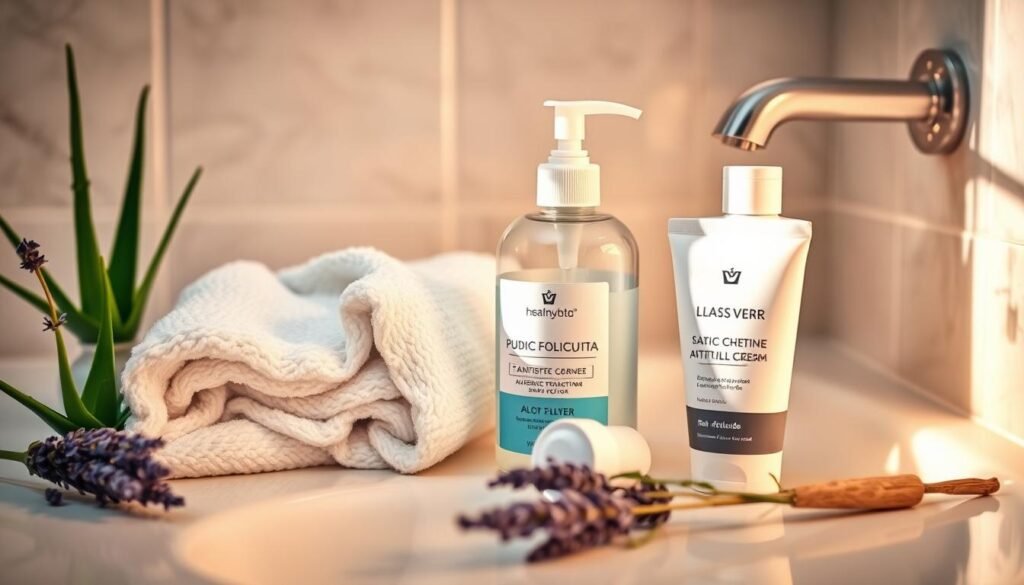About 80-90% of people might carry the Demodex mite. This tiny creature can cause pubic folliculitis. This issue makes hair follicles get inflamed, leading to sore, red spots. Sometimes, these spots turn into pus-filled bumps. The pubic area is especially prone to this annoying condition. So, it’s crucial for folks to know the symptoms and find good treatments.
In this article, we dive into pubic folliculitis. We discuss its symptoms, why it happens, and how to manage it. There are also photos of folliculitis in the pubic area. These images help you recognize the condition. Knowing about it can aid your well-being. Learning the management options lets you care for yourself and prevent the issue.
Key Takeaways
- Pubic folliculitis is caused by inflamed hair follicles, often appearing as red, tender spots.
- Understanding the symptoms and types of folliculitis can guide effective treatment options.
- Maintaining good hygiene is crucial to reducing the risk of developing pubic folliculitis.
- Photos of folliculitis in the pubic area can aid in visual recognition of the condition.
- Self-management strategies can significantly improve the healing process of folliculitis.
- It’s important to know when to seek professional help for persistent or severe cases.
Understanding Pubic Folliculitis
Folliculitis in the pubic area happens when hair follicles there get infected or inflamed. It’s often caused by bacteria, especially Staphylococcus aureus. You might feel itchiness and pain, particularly after shaving or waxing.
The folliculitis overview shows it’s more common in people who shave a lot. This can lead to swelling and infection. Mild cases can be treated with over-the-counter antibiotic creams. However, if it gets worse or stays, seeing a doctor is important.
Knowing the causes of folliculitis is key. People with diabetes, obesity, or weak immune systems are at higher risk. Skin problems like eczema can also increase your chances of getting folliculitis.
Small red bumps around hair follicles could appear, sometimes filled with pus when infected. Folliculitis severity varies. Most mild to moderate cases get better fast. But, without treatment, severe cases can lead to more issues. Understanding this helps in taking good care of yourself and getting the right treatment.
| Condition | Symptoms | Treatment Options |
|---|---|---|
| Pubic Folliculitis | Itchiness, pain, red bumps | Topical antibiotics, oral antibiotics |
| General Skin Conditions | Varies by condition | Prescription creams, laser treatments |
| Keratosis Pilaris | Rough patches, red bumps | Exfoliants, moisturizers |
Common Symptoms of Folliculitis
Small, red bumps that look like pimples are often signs of pubic folliculitis. These bumps are filled with pus and can make you itch and feel irritated. You might also see swollen skin areas, sore spots, or crusty patches. Spotting these visual signs early is key to getting the right treatment.
Folks with folliculitis might get it more than once. Sometimes, it can look a lot like acne, which makes figuring it out tricky. Knowing about the different symptoms is super important for getting help fast.
Understanding pubic folliculitis symptoms lets you make smarter choices about your skin care. Keeping your skin healthy can really cut down on these annoying infections. A better grasp of this issue can ease worry and help you figure things out better. For more info on spotting this condition, check out this useful link.
| Symptom | Description |
|---|---|
| Red Bumps | Small, inflamed areas resembling pimples |
| Pus-filled Spots | Bumps that may release pus when pressed |
| Swelling | Enlarged areas of skin around the inflamed follicles |
| Itching | Persistent urge to scratch the affected skin |
| Painful Sores | Lesions that can be tender to the touch |
Causes of Pubic Folliculitis
Figuring out why pubic folliculitis happens is key to stop and treat it. Lots of folliculitis triggers exist, but bacteria-infected cases are most common. Staphylococcus aureus bacteria is often to blame. Also, injuries to hair follicles from grooming can make things worse.
Top causes of pubic folliculitis are:
- Shaving or waxing, which can cause ingrown hairs
- Wearing tight clothes that bother the skin
- Using dirty hot tubs or pools, which can lead to hot tub folliculitis
Sensitive areas can get infected easily, especially with hair removal. Linking hair removal and folliculitis shows how they can cause irritation and infections. Knowing these causes helps people change their grooming habits and lower their risk.
To avoid bacterial infections, cleaning and exfoliation are vital. Learning what causes the issue helps people pick safer grooming methods. This protects their skin health.
Identifying Different Types of Folliculitis
It’s important to know the different types of folliculitis for treatment. You can find bacterial and yeast folliculitis. Each type looks different and needs its own approach. Bacterial folliculitis shows up as red, swollen bumps. It’s mainly due to Staphylococcus aureus and happens where clothes rub a lot. Yeast folliculitis, like Pityrosporum folliculitis, thrives in moist places and is often seen in people with weak immune systems.
When talking about pubic folliculitis types, razor bumps are common. They happen after shaving or waxing and can be very uncomfortable. However, they usually get better on their own. Knowing about different types, as explained in this guideline, can help you choose the right treatment.

- Hot Tub Folliculitis: This type is caused by Pseudomonas aeruginosa. You’ll notice it within 8 to 48 hours after being in contaminated water. Typically, it gets better from 7 to 14 days.
- Eosinophilic Folliculitis: This is often seen in Japanese males. It usually goes away by itself within 7 to 10 days.
- Tinea Barbae: Farmers usually get this on one side of their face from animals. It’s more common in males.
Some might get demodex-related folliculitis, which causes spots in oily face areas. Bartholin folliculitis shows red bumps around the upper lip and nose. Learning about these pubic folliculitis types helps doctors find the best treatment options.
| Type of Folliculitis | Common Causes | Typical Symptoms | Resolution Time |
|---|---|---|---|
| Bacterial Folliculitis | Staphylococcus aureus | Red, painful bumps | Varies, often self-limiting |
| Pityrosporum Folliculitis | Malassezia yeast | Itchy, red pustules | May persist if untreated |
| Pseudofolliculitis | Ingrown hairs from shaving | Inflamed bumps | Typically resolves on its own |
| Hot Tub Folliculitis | Pseudomonas aeruginosa | Red cystic nodules | 7-14 days |
Photos of Folliculitis in Pubic Area
Photos play a key role in recognizing skin problems like folliculitis. We have collected photos showing folliculitis in the pubic area. These images help people recognize the condition by showing different types of symptoms.
Visual Examples of Infection
Images show a variety of symptoms, from mild to severe. Mild cases look like small red bumps around hair follicles. Severe cases can show bigger sores or pus-filled bumps. Seeing these pictures helps tell apart minor irritations from serious infections. It’s important to check these out if you’re trying to figure out your symptoms.
Photos Comparing Folliculitis Types
Each type of folliculitis has unique signs. Bacterial types show red, swollen hair follicles. Pseudomonas folliculitis can pop up after being in contaminated water. Looking at these pictures helps understand the differences. This is helpful when looking for the right way to treat it.
| Type of Folliculitis | Appearance | Causes | Treatment |
|---|---|---|---|
| Bacterial Folliculitis | Red bumps or pustules | Skin-to-skin contact or contaminated items | Topical antibiotics and proper hygiene |
| Pseudomonas Folliculitis | Itchy, pus-filled bumps | Exposure to hot tubs or poorly maintained pools | Antibiotics and maintaining clean water conditions |
| Fungal Folliculitis | Red, scaly patches with hair loss | Overgrowth of fungi | Antifungal medications and proper skin care |
Home Remedies and Over-the-Counter Treatments
Dealing with mild pubic folliculitis can be easy. You might try home remedies and over-the-counter (OTC) treatments. A warm, moist washcloth on the area several times a day helps with the discomfort. Also, a vinegar mix (1 tablespoon of vinegar in 1 pint of water) can soothe the skin.
Self-care is crucial for dealing with mild infections. Washing gently with antibacterial soap keeps it clean. It’s best to avoid shaving and wear loose clothes to help healing. Over-the-counter antibiotic creams are good for starting treatment.
If yeast causes the issue, antifungal treatments are needed. They tackle fungal infections well. Those with HIV/AIDS might use steroid creams, especially for eosinophilic folliculitis.
Sometimes, you might need oral antibiotics for bad infections. Not everyone needs a doctor, as some cases clear up on their own. Knowing home remedies lets you handle symptoms better.

Learning about OTC treatments and self-care helps manage folliculitis. Preventive actions and knowing your options improve your comfort and skin health.
When to Seek Professional Help
Do you have folliculitis? Some signs point towards needing professional treatment for folliculitis. Many cases are manageable at home. But, sometimes, you must get a healthcare provider’s help for the right diagnosis and treatment.
Signs Indicating Serious Infection
Serious infection signs are important to catch early. If you see symptoms, a medical evaluation for folliculitis is a must. These symptoms include:
- Persistent pain that gets worse
- Fever with skin lesions
- Rashes that spread out
- Pus-filled blisters or bad-smelling discharge
- Symptoms not getting better after 2-3 days of home care
Knowing when to see a doctor is key to avoiding worse problems like cellulitis or losing hair for good. They might give you antibiotics or use different treatments for tough cases. Paying attention to these signs helps heal faster and reduces risks from not treating folliculitis.
Want more info on spotting and treating folliculitis? Check out this helpful guide on the subject.
Prevention Tips for Folliculitis
Keeping pubic folliculitis away involves good hygiene measures and personal care. It’s important to wash regularly with mild soap. This keeps the skin clean and bacteria-free. Also, wearing breathable fabrics helps a lot.
Don’t share personal items like razors to avoid bacterial infections. Always use a sharp, clean razor when shaving. This helps prevent irritation and ingrown hairs, often leading to folliculitis. Care for your skin after shaving or waxing to prevent folliculitis.
Using soothing creams and proper exfoliation can reduce inflammation. It also lowers the chance of hair follicle blockage.

Be careful about where you go, especially communal areas like pools and hot tubs. These places can have harmful bacteria if not well-kept. Keep hot tubs clean and maintain water chemistry to stop outbreaks.
If you sweat a lot or exercise often, staying clean is crucial. Shower quickly after workouts to keep your skin healthy.
Following these personal care tips can greatly reduce folliculitis risks. This leads to healthier skin and a better lifestyle.
Understanding the Impact of Hygiene on Folliculitis
Good hygiene is key to managing pubic folliculitis. Keeping clean reduces the risk of this uncomfortable skin condition. Effective hygiene cuts down the impact of cleanliness on skin health and bacterial infections.
Awareness of hygiene’s role in preventing folliculitis is crucial for better care.
Key Hygiene Practices for Preventing Folliculitis:
- Regular washing with antibacterial soap keeps the area clean and helps eliminate harmful bacteria.
- Avoid sharing towels, which can transfer bacteria and exacerbate the condition.
- Post-activity cleaning is essential, especially after exercising or swimming, to remove sweat and prevent clogged follicles.
- Wear loose-fitting clothing to reduce friction and allow the skin to breathe.
Not many realize the link between folliculitis and personal care. Shaving or waxing daily can irritate the skin, leading to folliculitis. Skipping regular hygiene can make some more prone, especially if they are overweight or have diabetes.
It’s crucial to take active steps in personal hygiene to keep skin healthy. Watching for skin issues and getting medical advice when needed is also key. Knowing the importance of hygiene can help avoid folliculitis, for healthier skin and a better life.
| Hygiene Practice | Benefit |
|---|---|
| Use of Antibacterial Soap | Reduces bacterial presence on skin |
| Avoid Shared Towels | Minimizes bacterial transmission |
| Regular Post-Activity Washing | Prevents clogged follicles and irritation |
| Wearing Loose Clothing | Reduces friction and allows skin to breathe |
Conclusion
Pubic folliculitis is manageable but sometimes uncomfortable. It often comes from infections like Staphylococcus aureus or Candida albicans. Knowing about folliculitis is key. This knowledge helps people manage symptoms and find relief.
Home remedies, certain medications, and good hygiene are crucial. They help prevent this skin condition. This advice is based on understanding how to avoid and treat folliculitis.
To prevent and treat it, avoid unsanitized shaving tools and tight clothing. These can worsen the condition. Spotting symptoms early and getting the right treatment are vital. This avoids serious issues like lasting hair loss.
Being aware and educated helps everyone. It allows us to take care of our skin confidently. We can handle pubic folliculitis well with this information.
